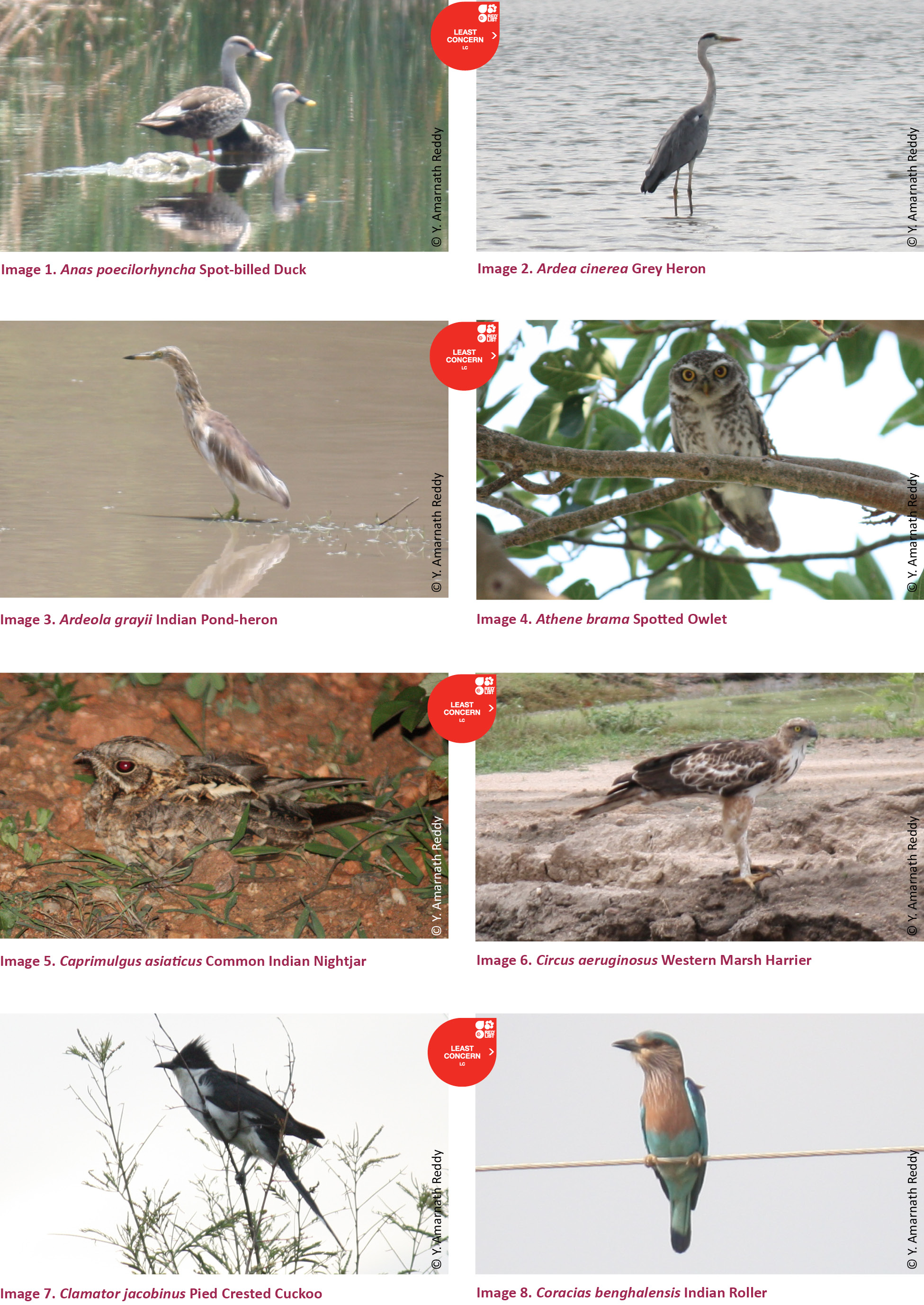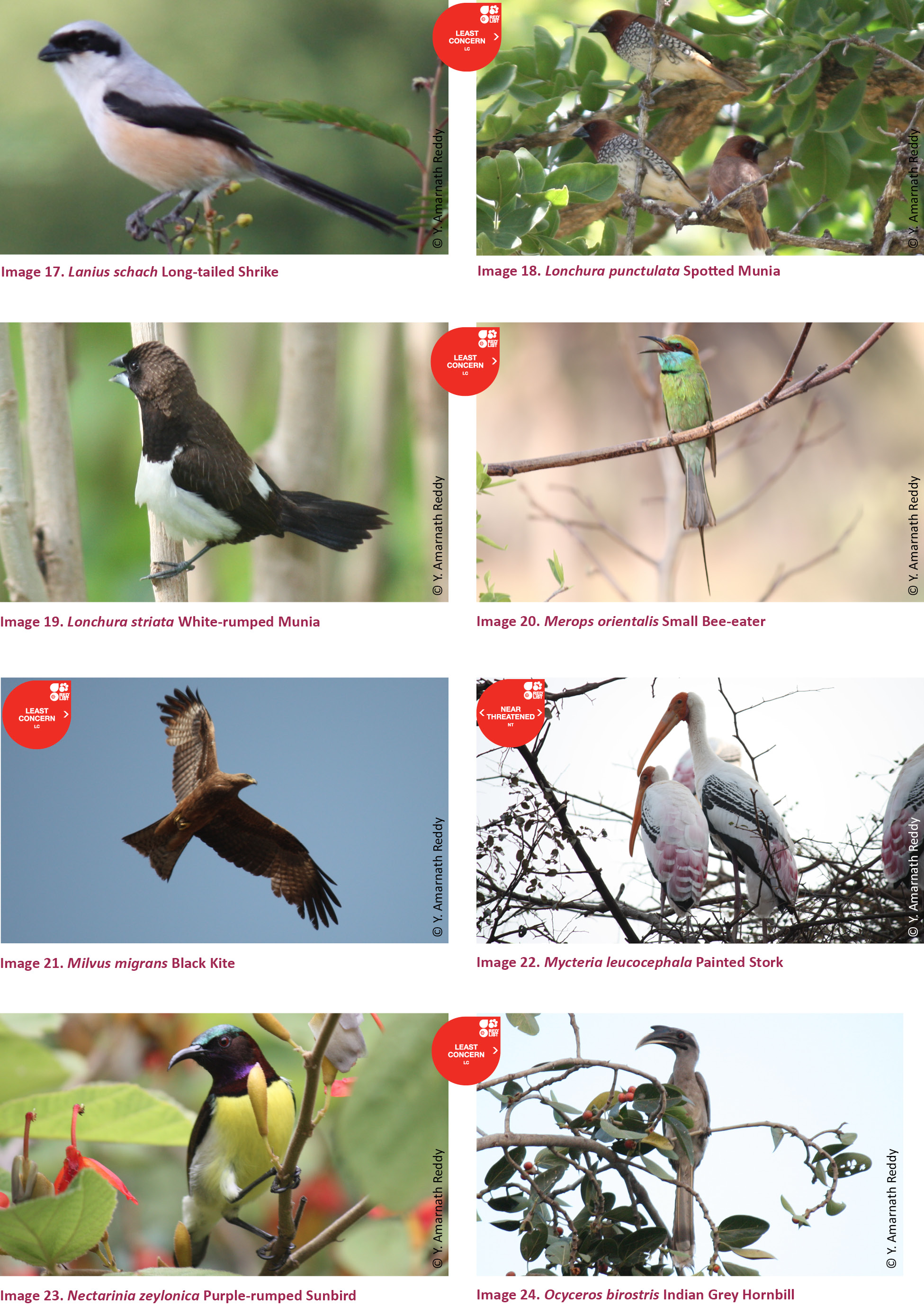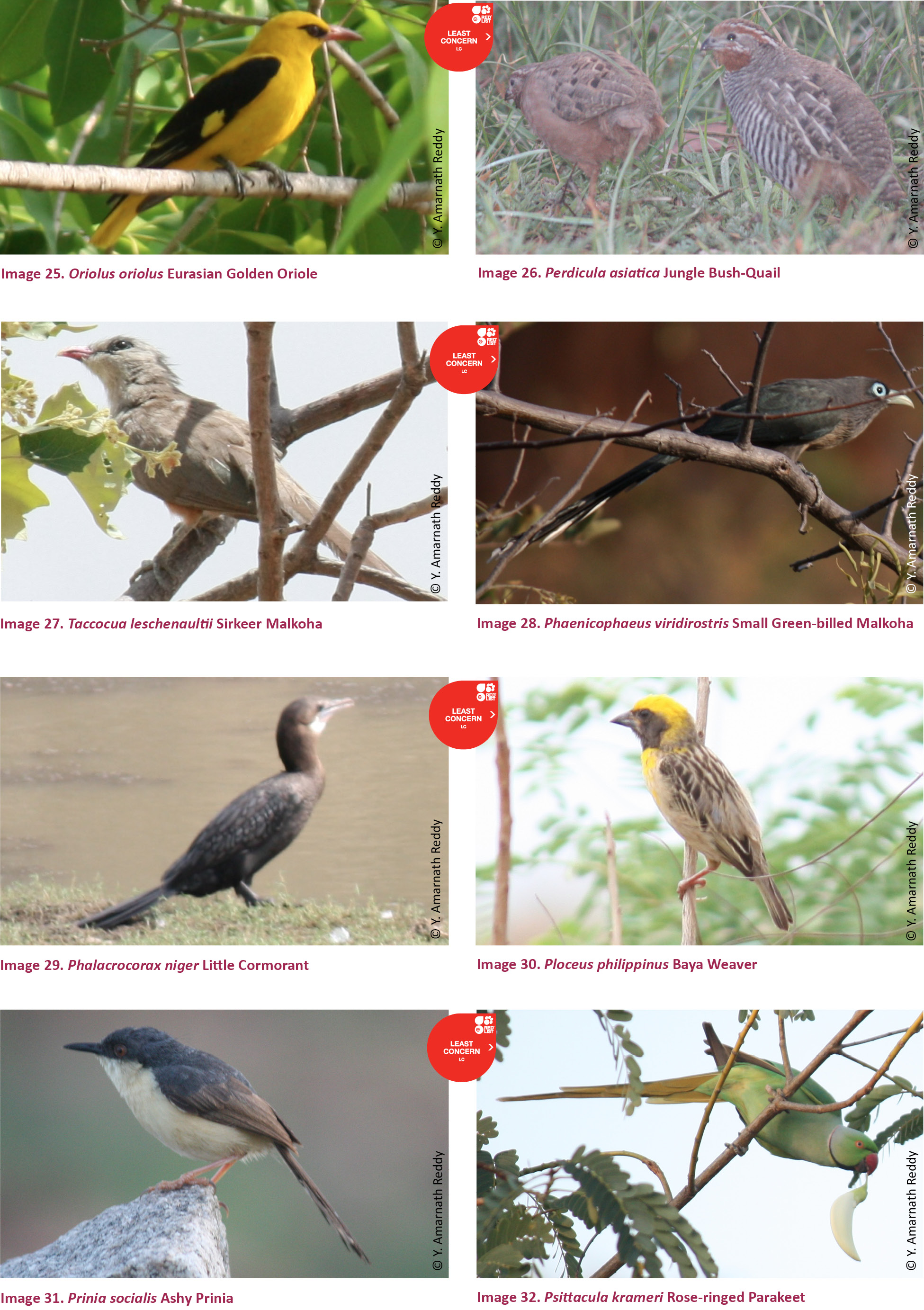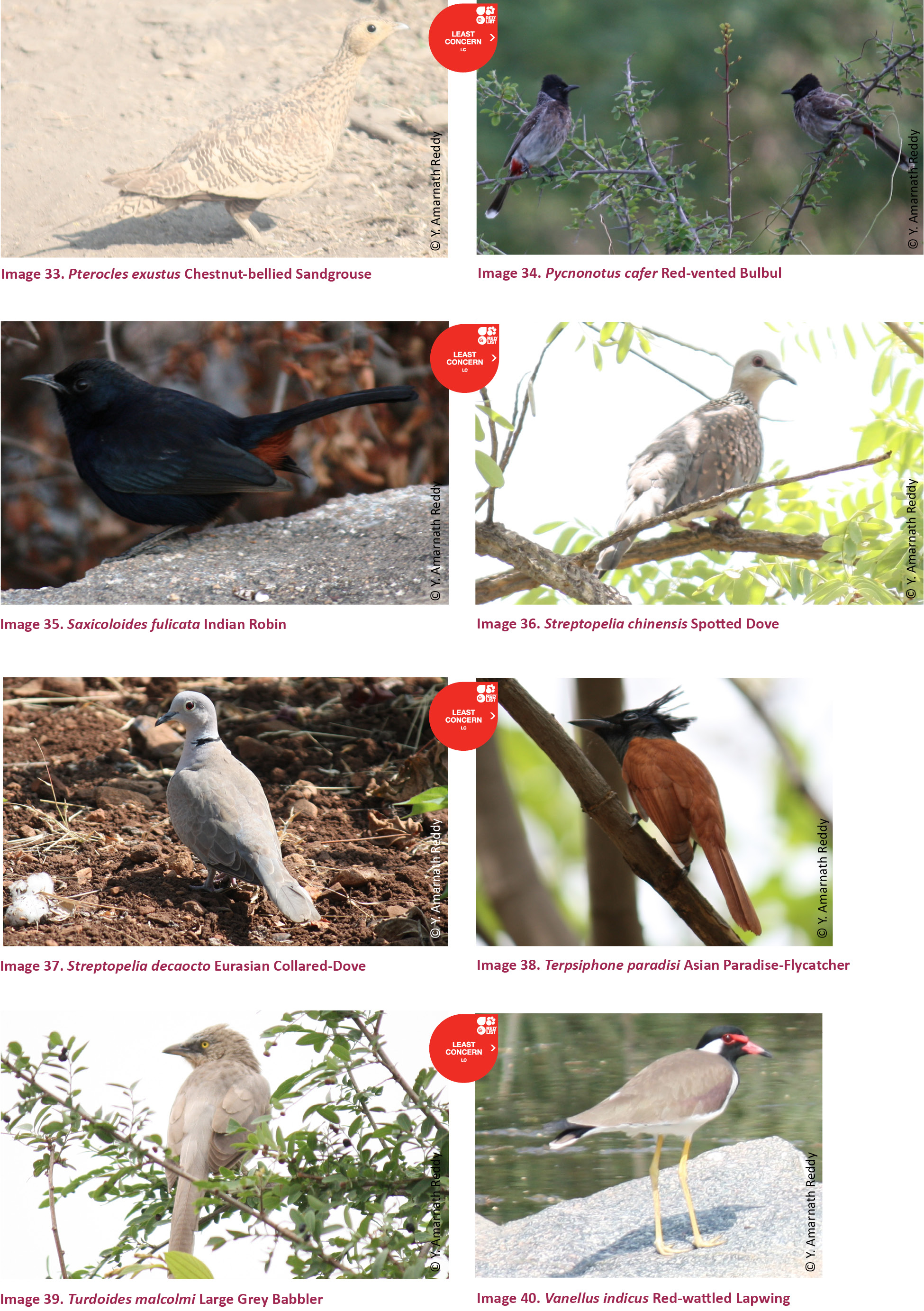Avifauna of Thummalapalle Uranium Mining Area, Andhra Pradesh, India
Y. Amarnath Reddy 1, B. Sadasivaiah 2, K. Rajakullaiswamy 3, P. Indira 4 & T. Pullaiah 5
1,4Department of Zoology, Sri Krishnadevaraya University, Anantapur, Andhra Pradesh 515003, India
2 Department of Botany, Govt. Degree & P.G. College, Wanaparthy, Mahabubnagar, Telangana 509103, India
3,5 Department of Botany, Sri Krishnadevaraya University, Anantapur, Andhra Pradesh 515003, India
1 amarzoology@gmail.com, 2 chumsada@gmail.com,
3 raju.botany@gmail.com, 4palaindira@yahoo.com,
5 pullaiah.thammineni@gmail.com (corresponding author)
doi: http://dx.doi.org/10.11609/JoTT.o3318.6556-65 | ZooBank: urn:lsid:zoobank.org:pub:D00DB7AA-73B1-47B9-B046-0A98EA719826
Editor: C. Srinivasulu, Osmania University, Hyderabad, Telangana. Date of publication: 26 November 2014 (online & print)
Manuscript details: Ms # o3318 | Received 22 August 2012 | Final received 29 October 2014 | Finally accepted 02 November 2014
Citation: Reddy, Y.A., B. Sadasivaiah, K. Rajakullaiswamy, P. Indira & T. Pullaiah (2014). Avifauna of Thummalapalle Uranium Mining Area, Andhra Pradesh, India. Journal of Threatened Taxa 6(12): 6556–6565; http://dx.doi.org/10.11609/JoTT.o3318.6556-65
Copyright: © Reddy et al. 2014. Creative Commons Attribution 4.0 International License. JoTT allows unrestricted use of this article in any medium, reproduction and distribution by providing adequate credit to the authors and the source of publication.
Funding: The project was funded by Board of Research in Nuclear Sciences, Department of Atomic Energy, Government of India vide number:
2008/36/34-BRNS/1991
Competing Interest: The authors declare no competing interests.
Acknowledgements: Authors are thankful to the funding agency for financial support. They are grateful to the Forest Department for permission to carry out the survey work.

Note
Habitat for wildlife is decreasing and deteriorating due to developmental activities all over the world affecting several species of animals and plants. Each and every species contributes to maintaining the ecological balance and healthy environment. Taxonomic studies and exploration of flora and fauna play a crucial role in assessing the threatened status of wild species and based on this conservation measures are undertaken. Human population is ever increasing all over the world, so the developmental activities are inevitable. India is a developing country, so it needs to augment its power production sources. The Uranium Corporation of India (UCIL) aims to produce 20,000 megawatts of power from nuclear fuel. It has identified the largest uranium deposits at a village Thummalapalle, YSR Kadapa District, Andhra Pradesh and started mining in 2011 (Chaki et al. 2011).
India harbors 10% of the world’s flora and fauna on only 2.4% of the landmass of the world (Venkatraman & Wafar 2005). The Indian subcontinent has rich avian diversity; it is the habitat to 1,300 species (Grimmett et al. 2000). Ornithological surveys in the past include Ali’s (1933–34) survey in Hyderabad State, followed by Abdulali (1945) and Ripley et al. (1987–88) in Visakhapatnam District. The recent works carried out on aviafauna of united Andhra Pradesh are Anand (2000), Srinivasulu (2004), Kannan et al. (2008), David et al. (2011), Narayana et al. (2013) and Prasad et al. (2014).
The present study focus on documentation of avifauna of Thummalapalle, Uranium Mining Area, Andhra Pradesh which has not been studied earlier.
Materials and Methods: Study area: Uranium ore is mined at Thummalapalle Village, which is in Vemula mandal of Kadapa District of Andhra Pradesh. The present study was carried out up to 30km all around the mining site of Thummalapalle and it consists of an area of 2,827km2. A portion (40%) of this study area extends to Anantapur District (Fig. 1). The study area encompasses forest area, agricultural land, barren land and human settlements. Elevation ranges from 190–800 m; climate can be considered as tropical and semi-arid type, temperature is between 270C and 470C and the average rainfall is 550–650mm. Water is scarce, and the streams Maddileru and Sagileru are the major spring streams which are tributaries of the Papagni River. A stretch of Papagni River flows to the east of the study area. Dry deciduous and scrub type forest cover extends over 30% of the area. The soil types are black cotton and red sandy to red gravely. Ground nut, paddy, banana, bengal gram, citrus and coriander are the major crops grown here.
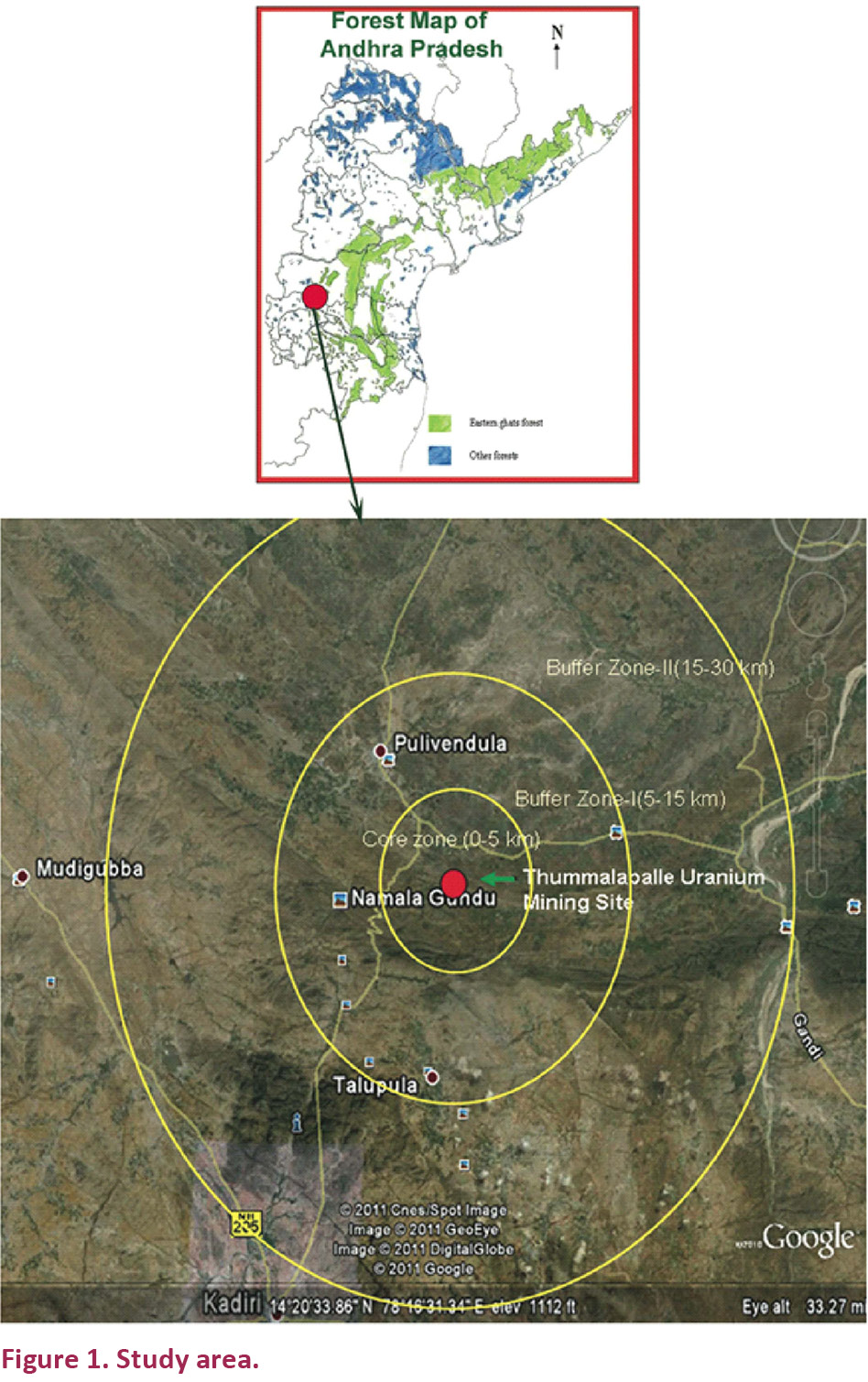
The survey was conducted for two-and-half years i.e., from September 2009 to March 2012 and the line transect method (Bibby et al. 1992) was followed for the study. The area was divided into eight parts, i.e., north, north-east, east, south-east, south, south-west, west and north-west and each part extended from the mining point to 30km radius. In each part, six permanent line transects of 1km length were laid. The search for avian fauna was done moving along the line transects and the whole study area was covered for each season (rainy season: June to October; winter: November–February; summer: March–May). The geographical coordinates of transects were noted with the help of a GPS. In addition to transects, birds observed opportunistically were also added to the list. Digital photographic records of the birds encountered were also maintained.
The birds were identified up to the species level following field guides and standard literature (Ali & Ripley 1987; Grimmett et al. 2000; Kazmierczak 2000). Common names, scientific names and classification follow Manakadan & Pittie (2001). Resident-migratory status follow ZSI (2008). Feeding guilds were classified based on our own observations and as per Ali & Ripley (1987). Bird Life International (2012) was followed for the threat category. The frequency of the birds was classified according to their occurrence in the line transects that were laid down. It is the ratio between the number of transects in which a species is encountered to the total number of transects laid in the whole study period, and it is as follows: Common (C) - recorded in more than 50% of transects, Occasional (O) - recorded in 20–50% of transects, Uncommon (UC) - recorded in 5–20 % of transect, Rare (r) - recorded in less than 5% of transects.
Results: A total of 99 species of birds, belonging to 43 families were recorded from the study area. The present study reveals that 47 species are common, 13 are occasional, 17 are uncommon and 22 are rare. The significant birds encountered during the study are presented in Images 1–40. The family Muscicapidae was the largest among all the others with 14 species and followed by Cuculidae with six species and Ardeidae, Accipitridae, Columbidae, and Estrildidae represented by five species each. Most of the species were resident (92 species), and only three species, namely, Actitis hypoleucos and Circus aeruginosus were winter migrants, while five species, namely, Ardea cinerea, Himantopus himantopus, Mycteria leucocephala, Pterocles exustus and Threskiornis melanocephalus were local migrants (Table 1). Feeding guilds of seven types were observed; omnivores were abundant with 29 species and followed by insectivores (28), carnivores (24), granivores (11), frugivores (3), nectarivores (3) and herbivores (1). A good number of wetland birds (22 species) were observed, of which 12 species were commonly seen in the study area. Mycertia leucocephala is assessed as Near Threatened and most of the other species belong to the Least Concern and a few species belong to the Not Evaluated category of IUCN (BirdLife International 2012).
Discussion and Conclusions: In Thummalapalle Uranium Mining area, the forest cover is only 30% and the remaining is occupied by agricultural lands and human settlements. Only two reserve forest areas, namely, Kalasamudram and Nigidi have dense and diverse vegetation compared to the remaining forest areas. In most of the forest area vegetation is made up of stunted trees and herbaceous species. In the present study only 99 species of birds were reported. The study area is not of specific type to offer a particular group of birds, so 20 families are represented by a single species each. Majority of the birds are omnivores, insectivores and granivores, only a few are frugivores and nectarivores. It implies that most of the study area is covered with herbaceous species and doesn’t have thick and dense vegetation. In the reported list, there were 22 wetland species, of which 12 were commonly seen in the study area. Many streams, ponds and ditches are full of water during the monsoon and dry up during summer, but wetland birds rely on these sources such as a few irrigation tanks, check dams with degraded level of water including rice fields during summer. Most of the species reported are common and usually seen in other similar areas of the country. The Painted Stork Mycertia leucocephala belongs to the Near Threatened category of IUCN Red List. It was recorded only in a few line transects and included in the rare category of frequency in study area.
Deforestation, hunting, forest fires, encroachments of forest area were observed and these are the main reasons for the deterioration of the existing forests in the study area. All these threats must be prevented to sustain wildlife of this area. The present study is only a baseline survey, and further studies on the impact of uranium mining ore on avifauna and other wildlife must be carried out.
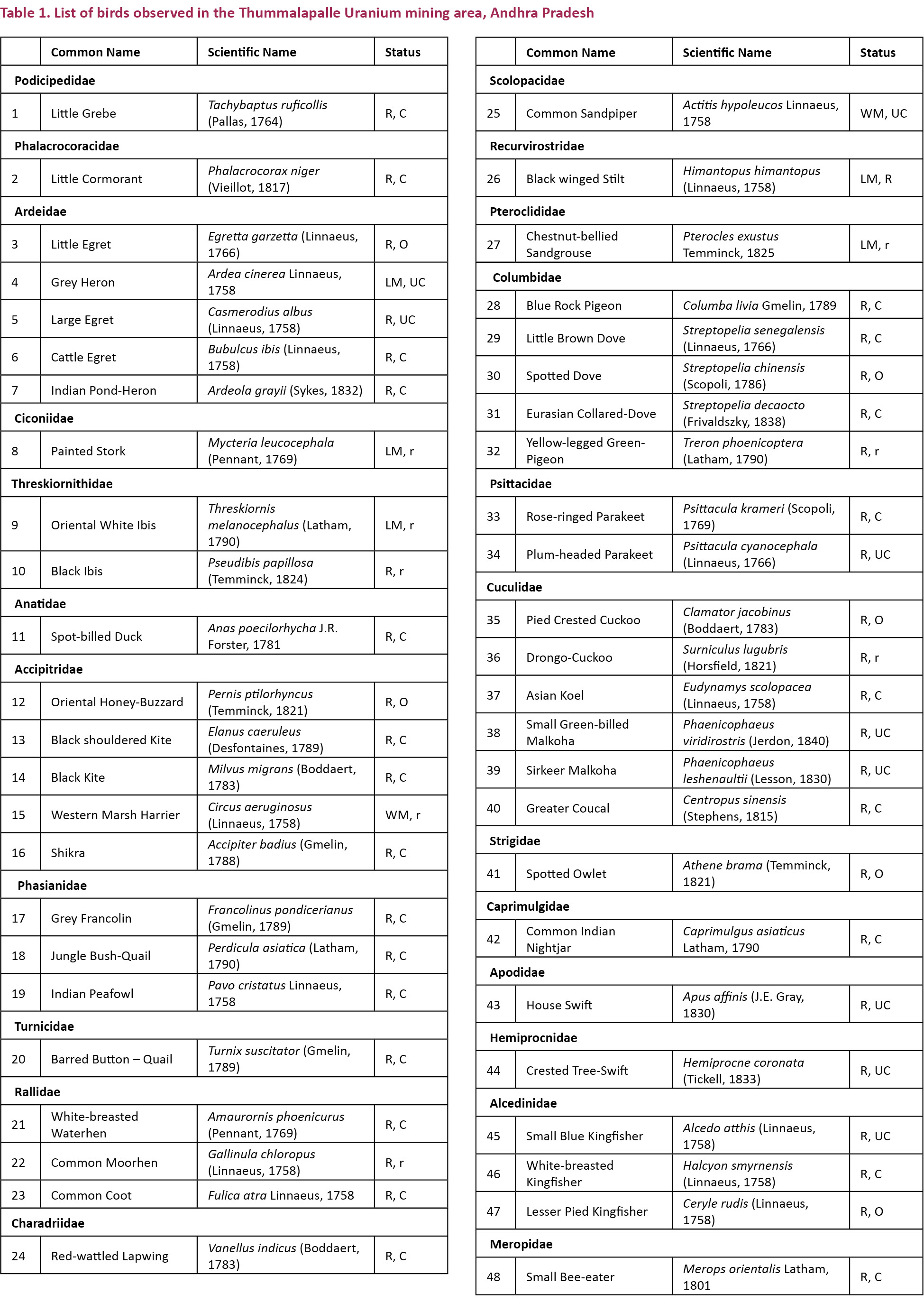
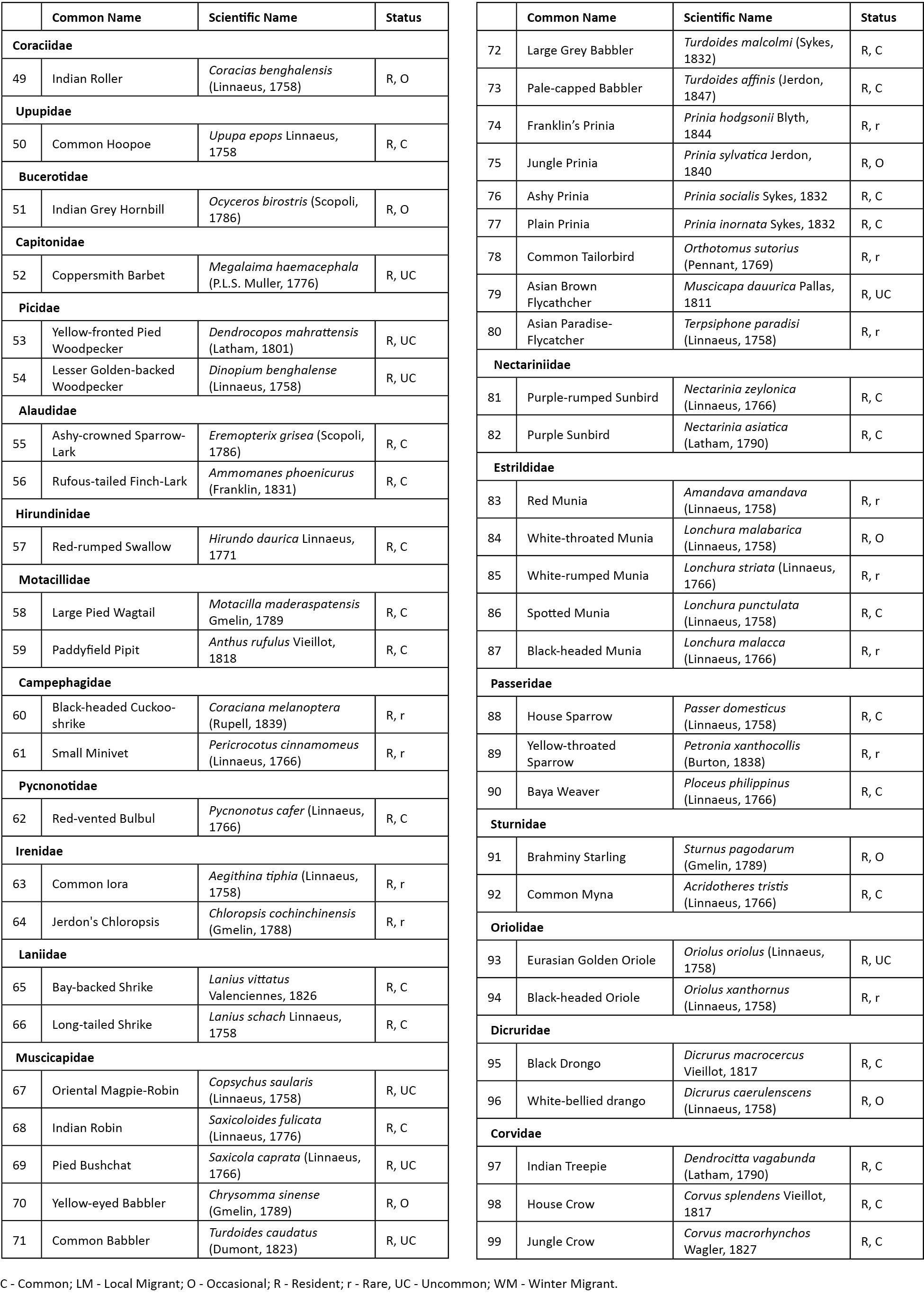
References
Abdulali, H. (1945). Birds of the Vizagapatnam District. Journal of Bombay Natural History Society 45(3): 333–347.
Ali, S. (1933–34). The Hyderabad state ornithological survey (part 1–5). Journal of Bombay Natural History Society 36(2): 356–390; 36(3): 707–725; 36(4): 898–919; 37(1): 124–142; 37(2): 425–454.
Ali, S. & S.D. Ripley (1987). A Compact Handbook of the Birds of India and Pakistan, (2nd Edition). Oxford University Press, Delhi, India, 737pp.
Anand, M. (2000). Birds in and around Sri Venkateswara Wildlife Sanctuary. Zoos’ Print Journal 15(10): 339–343; http://dx.doi.org/10.11609/JoTT.ZPJ.15.10.339-43
Bibby, C.J., N.D. Burgess & A. Hill (1992). Bird Census Techniques.Academic Press, London, New York, San Deigo, Boston, 248pp.
BirdLife International (2012). In: IUCN 2012: IUCN Red List of Threatened Species Version 2012.1. www.iucnredlist.org Downloaded on 15 July 2012.
Chaki, A., R.K. Purohit & R. Mamallan (2011). Lower grade uranium deposits of India - a bane or boon. Energy Procedia 7: 153–157.
David, J.P., B.S. Murugan & R. Mankadan (2011). Frugivory birds and mammals in Sri Harikota Island, southern India. Journal of Bombay Natural History Society 108(1): 24–40.
Grimmett, R., C. Inskipp & T. Inskipp (2000).Pocket Guide to the Birds of the Indian Subcontinent. Oxford University Press, New Delhi, India, 384pp.
Kannan, V., R. Manakadan, P. Rao, K.K. Mohapatra, S. Sivakumar & V. Santharam (2008). The water birds of Pulicat Lake, Andhra Pradesh - Tamil Nadu, India, Including those of the adjoining wetlands andheronries. Journal of Bombay Natural History Society 105(2): 162–180.
Kazmierczak, K. (2000). Birds of India, Sri Lanka, Pakistan, Nepal, Bhutan, Bangladesh and the Maldives. Om Books International, New Delhi, India, 352pp.
Manakadan, R. & A. Pittie (2001). Standardised common and scientific names of the birds of the Indian subcontinent. Buceros (ENVIS Newsletter) 6(1): I–IX; 1–37.
Narayana, B.L., V.V. Rao & J. Pandiyan (2013). Avifaunal assemblages in relation to different croplands/habitats of Nalgonda District, Andhra Pradesh, India. International Journal of Life Sciences Biotechnology and Pharma Research 2(3): 212–224.
Prasad, K.K., B.R. Krishna, C. Srinivasulu & B. Srinivasulu (2014).Avifaunal Diversity of Manjeera Wildlife Sanctuary, Andhra Pradesh, India. Journal of Threatened Taxa 6(2): 5464–5477; http://dx.doi.org/10.11609/JoTT.o3505.5464-77
Ripley, S.D., B.M. Beehler & K.S.R.K. Raju (1987–88). Birds of Visakhapatnam Ghats, Andhra Pradesh. (Part 1–2). Journal of Bombay Natural History Society 84(3): 540–559; 85(1): 90–107.
Srinivasulu, C. (2004). Birds of Kawal Wildlife Sanctuary, Andhra Pradesh, India. Journal of Bombay Natural History Society 101(1): 3–25.
Venkatraman, K. & M. Wafar (2005).Coastal and marine biodiversity of India. Indian Journal of Marine Sciences 34(1): 57–75.
ZSI (2008). Fauna of Andhra Pradesh: Part - 8. Aves. Zoological Survey of India, Kolkata, India, 68pp.
